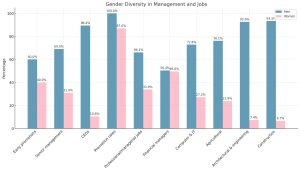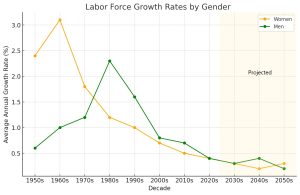In the modern corporate world, the issue of gender diversity in the workplace is increasingly critical. While women make up nearly half of the global workforce, they only represent about 21% of C-suite executives. This percentage highlights a significant disparity in leadership roles. The full spectrum of gender representation, especially in leadership and decision-making roles, is yet to be achieved. This disparity is not only in C-suite positions; it permeates various organizational levels, reflecting broader systemic issues. However, many companies are asking what they can do to attract, retain, and support female employees. Read more about The Best Work Perks for Women and the trends behind them.
Historically, the pursuit of gender diversity in the workplace has been marked by significant milestones such as the Equal Pay Act and has evolved to include the recognition of non-binary and transgender identities. The importance of this diversity extends beyond social justice; it is a crucial driver of economic innovation and ethical business practices.
Despite the clear benefits, challenges such as unconscious bias and systemic inequalities persist, creating barriers to true gender diversity in the workplace. As we delve into this topic, we will explore the current state, benefits, challenges, and strategies for a more inclusive and equitable work environment. Let’s begin by uncovering the issues, and then pave the way for a transformative shift in corporate culture.
The Current State of Gender Diversity
Challenging Disparities
Examining the current landscape of gender diversity in the workplace reveals a complex and varied picture across industries and at different levels of leadership. Data indicates that gender representation is not uniformly distributed. For instance, healthcare sectors and education sectors see a higher representation of women, whereas their presence in fields such as technology and finance is comparatively lower. This uneven distribution stresses the role industry-specific dynamics play in shaping the workforce’s gender makeup.
Another persistent and critical issue is the gender pay gap. On average, women earn just 82 cents for every dollar earned by men, a statistic that highlights systemic inequality in compensation. However, this gap is not just a matter of gender alone; it widens considerably when considering women of color and LGBTQ+ individuals. This disparity highlights the necessity of an intersectional approach in addressing gender diversity, recognizing that gender inequality intersects with other forms of discrimination to create unique experiences for different individuals.
The State of Gender Diversity Globally
Globally, gender diversity in the workplace presents a diverse picture.
Some countries have made significant strides in gender equality, backed by progressive initiatives and policies. For example, Nordic countries like Iceland, Finland, and Norway are often lauded for their progressive gender equality measures. Iceland, in particular, has consistently been at the forefront, implementing robust policies such as equal pay certifications for companies and parental solid leave policies that apply to all genders. These initiatives contribute significantly to a more balanced gender representation in various sectors.
In contrast, countries like Japan and South Korea, despite being economic powerhouses, struggle with gender diversity in the workplace. Cultural norms and traditional gender roles play a significant role in this, with women often expected to leave their jobs after marriage or childbirth. This cultural expectation is compounded by insufficient support for working mothers, such as limited access to childcare and paternal leave policies. In other regions, legal barriers significantly impact gender diversity. For instance, in some Middle Eastern countries, women’s participation in the workforce is restricted by laws and societal norms, limiting their roles and advancement in specific industries.
These examples illustrate the spectrum of challenges and successes in achieving gender diversity in the workplace globally. They underscore the need for context-specific strategies that consider cultural, legal, and societal factors to address and promote gender diversity effectively.
Moving Forward
Gender diversity in the workplace is an evolving narrative characterized by progress and persistent challenges. Understanding this state is crucial in formulating effective strategies for a more inclusive and equitable working environment for everyone.

The Benefits of Gender Diversity
Innovation and Creativity
Research consistently shows that gender-diverse teams are more innovative, reflected in the policies and performance of leading global companies. For example, Google has implemented diversity initiatives like ‘I Am Remarkable,’ which encourage women to speak openly about their achievements, fostering a culture of recognition and innovation. Similarly, IBM has been recognized for its diversity and inclusion efforts, with programs that support women in technology jobs, leading to a workplace that thrives on creative solutions and diverse perspectives.
Enhanced Decision-Making
Gender-diverse teams are not only innovative but also excel in making balanced decisions. For instance, McKinsey & Company found that companies with more diverse gender representation on their executive teams were 25% more likely to experience above-average profitability. This correlation highlights the tangible benefits of diverse viewpoints in strategic decision-making, ensuring well-rounded decisions and effectively addressing varied market demands.
Attracting and Retaining Talent
Companies that champion gender diversity are more attractive to prospective employees. For example, Salesforce has made strides in this area by conducting annual employee compensation reviews to eliminate gender pay gaps, enhancing its appeal as an equitable workplace. This focus on diversity and equality aids in attracting and retaining top talent, as employees are more likely to feel valued and committed to companies that demonstrate a commitment to inclusivity.
Societal Benefits
The impact of gender-diverse workplaces extends beyond organizational boundaries to societal benefits. Studies have shown that increasing women’s participation in the workforce can contribute significantly to GDP growth. For example, according to the World Bank, increasing female labor force participation in India could substantially boost GDP growth. This illustrates how gender diversity in the workplace can catalyze broader economic and social progress.
Progressing Gender Diversity in the Workplace
Organizations can make significant strides toward promoting gender diversity in the workplace, creating a more equitable and inclusive environment for all employees by implementing these strategies:
Revamping Internal Talent Mobility (ITM) Programs
Modern ITM programs are being reshaped to democratize access to opportunities, particularly benefiting women in the workplace. These programs promote the visibility of career opportunities and are designed to mitigate biases by focusing on skills and preferences rather than personal attributes. For instance, companies like Seagate Technology have implemented talent marketplaces that suggest jobs based on skills and aspirations, disregarding factors like gender. This approach has led to a 58% increase in the participation and assignment of women to open internal positions.
Educational Initiatives and Gender Diversity Training
Raising awareness and understanding of gender diversity issues is crucial. This involves educating teams about the workplace gender gap and implementing gender diversity training, especially unconscious bias training for hiring managers. Such initiatives help create a fairer and more objective hiring process promoting gender diversity.
International Women’s Day is an excellent opportunity for companies to raise awareness about gender diversity issues. Continuous education and sensitivity training throughout the year help nurture an inclusive environment.
Implementing Fair Compensation Practices
Conducting regular pay equity analyses ensures fair compensation across genders. Regularly reviewing and adjusting compensation strategies is essential, focusing on salary bands based on experience, skills, and performance rather than gender. This approach helps in addressing gender and racial pay gaps.
Again, Salesforce is an example of a company that annually reviews employee compensation to eliminate gender pay gaps. Regular compensation analyses ensure fair pay practices across the organization.
Developing Equitable Policies
It is essential to review internal policies to ensure they are fair and equitable, especially those impacting women. Policies like the Pregnant Workers Fairness Act, which went into effect on June 27, 2023, could include protections against pregnancy discrimination, support for nursing mothers, and benefits to aid women with children. Flexible work models, childcare support, and ensuring a gender-equal company culture are vital to such policies.
As seen in companies like Unilever, offering flexible work arrangements and childcare support helps support women with children. It encourages them to return to post-maternity leave, thus maintaining their career trajectory.
Analyzing and Improving the Recruitment Process
A gender-neutral recruitment process is fundamental to achieving gender diversity. This includes creating inclusive job descriptions, using gender-neutral language, and proactively sourcing a gender-diverse candidate pipeline. Ensuring a diverse interview panel also helps make the recruitment process more inclusive.
Data-Driven Approach
Keeping track of gender diversity metrics is vital. DEI initiatives impact a company’s growth. Metrics like hiring, promotion, satisfaction, and retention rates can help track progress. Factorial’s HR reporting tools can help analyze diversity metrics for data-driven decisions.
Conducting Exit Interviews
Regular exit interviews provide direct insights into the employee experience regarding gender diversity. Analyzing feedback from these interviews is crucial in identifying issues and implementing measures to address them.
Adopting these multifaceted strategies positions organizations to champion gender diversity in the workplace effectively. Such efforts foster a more equitable and inclusive environment and catalyze broader organizational success and societal progress. By embracing these approaches, companies pave the way for a diverse and dynamic workforce where every employee, regardless of gender, can thrive and contribute meaningfully.

Champions of Gender Diversity in the Workplace
Two influential voices stand out when discussing gender diversity: Sheryl Sandberg and Melinda Gates. Their perspectives offer practical advice, personal experience, and visionary goals that can guide efforts toward more significant gender equity in the workplace.
Sheryl Sandberg
A notable advocate for women in the workplace and has shared numerous insights. Here are some paraphrased highlights of her thoughts:
- Glass Ceiling and Progress: Sandberg highlights a stagnation in women’s progress in reaching top corporate positions. Despite women gaining more educational qualifications and entering the workforce in increasing numbers, there’s been little change in their representation at the top levels.
- Her Vision of Success: She desires a world where all people are equally supported and cheered on for their choices, whether it’s a man choosing to be a stay-at-home parent or a woman pursuing a career outside the home.
- Gender in the Workplace: Sandberg discusses her experience of initially not acknowledging her identity as a woman in her professional journey. She emphasizes the importance of recognizing and embracing one’s gender to foster change in the workplace.
- Encouraging Women to Lead: Highlighting the disparity in ambition between people from a young age, Sandberg stresses the need to motivate women to aspire to leadership roles. She points out women’s societal and cultural discouragements as they become more successful, unlike men, who often receive increased likability and support. Source
- Importance of Resilience: Sandberg believes resilience is a crucial quality that is not inherent but developed over time. This resilience is critical in overcoming challenges and reaching one’s potential.
- Women Supporting Each Other: She underscores the importance of supporting one another, noting that other women have uplifted many successful women.
- Combining Passion and Contribution: Sandberg sees the combination of passion and contribution as a clear path to happiness and a luxurious way to live one’s life.
- Whole Self at Work: She encourages bringing one’s entire self to work, breaking the dichotomy of a ‘professional’ and ‘real’ self, and embracing both in the workplace. Source
Melinda Gates
Another notable advocate who offers several compelling insights on gender diversity and equality. Here are some paraphrased highlights of her thoughts:
- Women’s Unpaid Labor: Gates emphasizes recognizing and properly valuing women’s unpaid labor, essential for supporting families and contributing to economic systems. She advocates for rebuilding this system to support families and broader societal structures.
- Gender Equality and Investment: Reflecting on her decision to invest a billion dollars in the Equality Can’t Wait initiative, Gates underscores the significance of gender equality. She points out the power of financial investment in promoting women’s leadership and enhancing diversity in positions of power.
- Strengthening Male Allies: Gates highlights the need for men to actively participate in and commit to promoting diversity within their organizations. She suggests that men in leadership should not only mentor but also sponsor women for job opportunities, contributing to a culture that boosts women’s confidence and professional growth.
- the Importance of Connections with Women: Gates shares her experience of the vital support she receives from her connections with other women. She notes that these relationships have been crucial, providing encouragement and motivation during challenging times.
- Being a ‘Possibilist’: Gates describes herself as a ‘possibilist’ who recognizes societal problems but focuses on opportunities for change. She uses the example of the COVID-19 pandemic, exposing the reliance on women’s unpaid labor to highlight the potential for societal transformation.
- Women as Architects of the Future: Gates envisions a future where there is a better balance between work and family life, a reimagined workforce that is more reflective of current societal needs, and greater flexibility in work arrangements.
- Empowering Women: Gates believes in investing in women as a critical driver of global development. She emphasizes the need to empower women to unlock their potential and their children’s potential.
Sandberg and Gates, through their experiences and initiatives, provide a blueprint for advancing gender diversity in the workplace. They highlight the need for systemic change, the power of resilient and supportive networks, and the importance of diverse leadership.
The Future of Gender Diversity in the Workplace
Emerging Trends and Opportunities
- AI-Driven Hiring Processes: Adopting AI and technology in hiring processes presents new opportunities for enhancing gender diversity. AI-driven tools can help reduce unconscious bias in recruitment, ensuring a more equitable selection process, however, AI can be a double-edged sword. IBM is a prime example of using AI in recruitment to enhance diversity. Their AI-driven tool helps screen candidates without bias, focusing on skills and experiences over other factors. Such tools are crucial in making hiring processes more inclusive and diverse.
- Remote Workforce: The shift towards remote work is here to stay. This change offers a unique opportunity to create more flexible and inclusive work environments that benefit women who balance work and home life. Remote work models can enable a more diverse workforce by removing geographical barriers and providing flexibility. Companies like Twitter and Facebook have embraced remote work, offering employees flexibility in their working locations. This shift not only aids in accessing a wider talent pool but also supports work-life balance, which is particularly beneficial for women and caregivers.
Challenges to Address
- Automation and Workforce Demographics: The rise of automation poses potential risks to job security in specific sectors, particularly affecting roles predominantly held by women. Additionally, changing workforce demographics necessitate a deeper understanding of the needs and aspirations of a multigenerational workforce, where each generation brings unique experiences and expectations to the workplace. With automation affecting jobs, particularly in sectors with a high proportion of female employees, companies must offer retraining and upskilling opportunities. For example, Amazon’s upskilling programs aim to prepare employees for future automated workplaces.
- Systemic Change: The events of recent years, including social movements and increased awareness of systemic injustices, have highlighted the need for systemic changes in workplace policies and culture. This includes combating discrimination and ensuring equity for underrepresented groups. In response to systemic injustices underscored in recent years, organizations like Google have implemented comprehensive DEI (Diversity, Equity, and Inclusion) strategies, focusing on equitable policies and inclusive cultures.
Taking Action and Practical Steps Forward
- Advocate and Lead by Example: Encourage gender diversity by leading through example. Leaders and managers can actively promote and participate in diversity initiatives, fostering an inclusive culture.
- Diversity Training: Regular training sessions on diversity and inclusion can be beneficial. For instance, Salesforce offers extensive training programs focusing on understanding and addressing unconscious bias.
- Inclusive Policy Development: Review and update policies to ensure they support gender diversity. For example, Netflix’s parental leave policy offers flexibility and support to all parents, promoting gender equality in caregiving.
- Support Employee Networks: Encourage and support the formation of employee resource groups (ERGs) for women and other underrepresented genders. ERGs can provide a platform for support, mentorship, and advocacy within the organization.
- Mentorship and Sponsorship Programs: Implement programs that pair less experienced employees with more seasoned professionals for guidance and support. For example, Intel’s mentorship programs have effectively supported women in tech roles.
- Transparent Progress Tracking: Regularly track and share progress on gender diversity goals. Transparency in diversity metrics can hold the organization accountable and ensure continuous improvement.
By embracing these trends and addressing the challenges, organizations can forge a path toward a more gender-diverse and inclusive future. The steps outlined provide a roadmap for individuals and companies to actively contribute to this positive change, fostering environments where everyone, regardless of gender, can thrive and contribute to their fullest potential.
FAQ’s
What is Gender Diversity in the Workplace?
Gender diversity in the workplace refers to an equitable representation and inclusion of different genders within an organization. This includes men, women, non-binary, and transgender individuals, ensuring a diverse and inclusive environment.
Why is Gender Diversity Important in the Workplace?
Gender diversity fosters innovation and creativity, improves decision-making, and enhances workplace productivity. Diverse teams bring varied perspectives that lead to more comprehensive problem-solving and strategies. Additionally, it promotes social justice and equal opportunities for all employees.
How Does Gender Diversity Affect a Company’s Performance?
Companies with higher gender diversity often see improved performance, profitability, and productivity. For example, McKinsey & Company found that companies with diverse gender representation on their executive teams were 25% more likely to experience above-average profitability.
What Are Some Challenges to Achieving Gender Diversity in the Workplace?
Challenges include unconscious bias, systemic inequalities, and cultural norms that hinder the inclusion and advancement of diverse genders. Additionally, the gender pay gap and insufficient support for work-life balance can also be significant barriers.
How Can Organizations Promote Gender Diversity?
Organizations can promote gender diversity by implementing fair compensation practices, educational initiatives, gender-neutral recruitment processes, and developing supportive policies such as flexible work arrangements and parental leave. Regular diversity training and mentorship programs also play a crucial role.
What Role Do Leaders Play in Enhancing Gender Diversity?
Leaders play a critical role in advocating for and modeling inclusive behaviors. Leaders can promote a more inclusive workplace by prioritizing diversity, supporting initiatives, and leading by example.
How Can Individuals Contribute to Gender Diversity in Their Workplace?
Individuals can contribute by actively participating in diversity and inclusion programs, challenging discriminatory behaviors, and supporting colleagues from different genders. They can also engage in mentorship opportunities and advocate for fair practices and policies.
Conclusion
Clearly, a commitment to gender diversity in the workplace breeds innovation, drives economic growth, and creates a work environment where everyone, regardless of gender identity, can thrive.
Leadership plays a pivotal role in this transformation. By setting the tone for an inclusive culture, implementing equitable policies, and actively advocating for gender diversity, leaders can make a significant impact. Individuals also have a role in this narrative – supporting diversity initiatives, mentoring, and standing against biases and unfair practices.
The future of work hinges on our ability to integrate and celebrate diverse perspectives and experiences. As we navigate this ever-evolving landscape, let us commit to creating workplaces recognizing and celebrating gender diversity as a cornerstone of success and innovation.
Embrace your diversity job search, the change, and be part of the movement. Join Diversity Employment today, and together, let’s shape a more diverse, inclusive, and equitable future.




